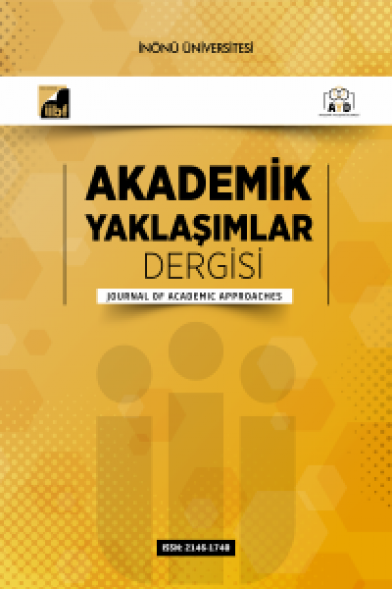Döviz Kuru, Verimlilik ve İhracat Nedensellik Analizi
En temel ekonomik göstergeler arasında yer alan dış ticaret bilgileri, Türkiye için 1980 sonrası anlamlı hale gelmeye başlamıştır. Kısıtlı olan ithalat ve yeterli düzeye bir türlü erişemeyen ihracat liberal ekonomiye geçişle beraber ekonominin en önemli belirleyicilerinden biri olmuştur. Türkiye gibi kendi parası dışındaki bir para birimiyle ticaret yapan ülkeler için dış ticaret aynı zamanda bir risk oluşturmaktadır. Bu durumda çoğu ülkeyi dış ticarete karşı korumacılığa itmektedir. Ülkeler ithalatı kotalar ve yüksek gümrük vergileriyle kontrol altına almaya çalışmış, ülkedeki dövizin yurtdışına çıkmasını zorlaştırmaya çalışmışlardır. Çalışmada ihracatı etkileyen faktörlerden döviz kuru ve verimlilik incelenmiştir. Amaç Türkiye’de 1992- 2009 yılları arasında 6 aylık veriler kullanılarak döviz kuru, ihracat ve verimlilik arasında bir nedensellik ilişkisi olup olmadığını incelemektir.
Anahtar Kelimeler:
İhracat, Döviz Kuru, Emek Verimliliği
The international trade statistics became more important after 1980 due to the liberalization policies. The increasing imports and insufficient exports are always an important issue for Turkey policy makers. International trade policies are one of the determinants of the economic system in Turkey. Especially for countries like Turkey that uses another currency for international trade has a big risk in terms of currency movements. So some of the countries in the world implement some trade restriction policies in order to avoid this risk. On the other hand some other countries try to find a policy that they will increase the exports and reach a more stabile economy. In our study, we tried to explore the relation of the exports of Turkey with the FX rate and the productivity using the data from 1992 – 2009 in 6 months period
Keywords:
Export, Labor Efficiency, Foreign Currency Rate,
___
Akbostancı E. (2002). “Dynamics of the Trade Balance: The Turkish J-Curve” ERC Working Papers in Economics 01/05 Kasım 2002.Conzeri, M.B., Cumby, R., E., Diba, B., (1999).“Relative Laubor Productivity and Real Exchange Rate in the Long Run”, Juornal of International Economics.
Dickey, D. A., Fuller, W. A. (1981) “The Likelihood Ratio Statistics for Autoregressive Time Series with a Unit Root”, Econometrica, 49, s. 1057-1072.
Doğan Çetin, K.Murat, “Döviz Kuru Dış Ticaret İlişkisi: Türkiye Örneği” (2005). Fırat Üniversitesi Sosyal Bilimler Dergisi Cilt: 15, Sayı: 2, ss: 219-228.
Dünya Ticaret Örgütü İstatistikleri Erişim Tarihi; 25 Mart 2011 http://www.wto.org/english/res_e/reser_e/reser_e.htm Engle, R. F. ve Granger, C. W. J. (1987). “Co-Integration and Error Correction: Representation, Estimation, and Testing”, Econometrica, pp. 251-276.
Erdal Ünsal; (2009) Makro İktisat; İmaj Yayıncılık; İstanbul.
Ertek T. (1996).Ekonometriye Giriş, İstanbul; Beta Yayınları.
Kutlar, A.(2000).Ekonometrik Zaman Serileri, Gazi Kitabevi Yayınları, Ankara.
Kumar, S., R. R. Russell. (2002) “Technological Change, Technological Catch-up, and Capital Deepening: Relative Contributions to Growth and Convergence.” American Economic Review.92 pp:527-548.
OECD Main Science and Technology Database, (2009). Main Science and Technology Indicators (2007), Erişim Tarihi Kasım 20, 2010, www.stats.oecd.org Measuring Productivity OECD Manual, Measurement of Aggregate and Industry-Level Productıvıty Growth, 2001 (http://www.oecd.org/dataoecd/59/29/2352458.pdf) (ErişimTarihi: 05.12.2010)
Öztürk, İ. and Acaravcı, A. (2002). “The effects of exchange rate volatility on the Turkish export: an empirical investigation”, Review of Social, Economic and Business Studies, Sayı 2, Fall 2002-2003, 197-206.
Yıldırım A. (2007) “Samuelson-Balassa Hipotezi ve Reel Döviz Kuru”; Finans Politik & Ekonomik Yorumlar Cilt: 44 Sayı:509 ss. 9-20.
- Yayın Aralığı: Yılda 2 Sayı
- Başlangıç: 2010
- Yayıncı: Gökhan Tuncel
Sayıdaki Diğer Makaleler
Hilmi KIRLIOĞLU, İsmail Fatih CEYHAN
Döviz Kuru, Verimlilik ve İhracat Nedensellik Analizi
İşlem Bazlı Manipülasyon Şirketlerinin Vektör Otoregresif Analizi İle İncelenmesi
Savaş TARKUN, H.oğuzhan ERGÜR, A. Fahimi Aydın
Yeni Vergi Denetimine Genel Bir Bakış: Uyulması Gereken İlkeler ve İşleyişi
Kurumsal Sürdürülebilirlik ve Muhasebeye Yansımaları: Sürdürülebilirlik Muhasebesi
Kamu Yönetiminde Etik Denetimi: OECD Ülkeleri Örneği
Gümrük Birliği Üyeliğinden Günümüze Türkiye’nin Diş Ticareti Üzerine Bir İnceleme
